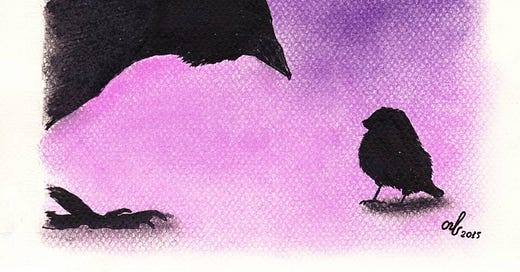On January 14, 2022, I wrote the NYC Microfiction Short Story Competition Challenge.
I was given the following criteria to use in my story:
Genre: Spy
Subject: Robotics
Character: An embezzler
Length: 2,500 words (Maximum)
This is the feedback I received on my short story called, "Sparrows and Ravens".
Dear Anita Wladichuk,
The feedback from the judges on your 1st Round submission from the Short Story Challenge 2022 is below. We hope you find the feedback helpful and you’re proud of the story you created for the challenge. Thank you for participating and we hope to see you in a future competition!
''Sparrows and Ravens'' by Anita Wladichuk -
WHAT THE JUDGES LIKED ABOUT YOUR STORY - {2111} The premise of the story is interesting, with a child who felt underestimated and exceeded everyone's expectations. Rural Canada is a creative setting with lots of potential for drama to build. I'd like to know more what Raven, Sparrow and Mata Hari are. {1919} Sparrows and Ravens has an intriguing narrator whose compelling backstory draws the reader in. Her realm of experience from being a child thief, to check forger, to hitchhiker to exotic dancer often makes the reader wonder if any of her tale is true, or if she's simply woven together an imaginative and impressive false narrative about her life. The creative premise helps propel the story forward. {1966} I like our main character. She seems smart and resourceful. She's very self-aware and astutely in-tune with how she ended up in a life of crime.
WHAT THE JUDGES FEEL NEEDS WORK - {2111} The entirety of the story is written in exposition, with the main character reflecting on their life. For the story to be complete, we need to see Northern Saskatchewan. When you explain, "I perfected my writing skills by becoming ambidextrous," this needs to be shown rather than told. Pick a point in time to tell the story from and stay there. Phrases like "As I said earlier" make this sound like a conversation between two people. {1919} Since the entire story is mostly stream of consciousness, you might try to fill in some blanks to help tighten up the plot. For example, how did she transition from being a kid committing crimes to starting a career in computers and climbing the industrial ladder? Leaps like this in the narrative can be confusing and make the reader wonder if she's a reliable narrator after all. If she is, make sure you include those transitions. If she's not, then pepper in more outlandish and wild claims of hers that eventually add up to the reader not believing any real part of her tale. {1966} I would suggest you consider showing us the story rather than telling us. Relate the information through sensory details and actions rather than exposition. This will make the story more immersive for the reader, allowing them to “be in the room” with the characters.
Like Chekhov said, “Don’t tell me the moon is shining. Show me the glint of light on broken glass."
For example:
"One night, we climbed into a car and the driver was acting very strange. He was asking us questions which made me feel very uncomfortable. We were in danger and I knew it."
Could read:
I poured one friend after another into the back of a taxi. They giggled and pushed each other. I turned my head against the smell of cheap beer and stale cigarettes. As I waited for them to settle, I noticed the driver. He tilted his head from side to side as his eyes darted scanning the street beyond the hood of the car. I tried to follow his gaze, but I couldn't see what he might be looking at.
"I think we're all set here," I said.
He didn't move. "Are your parents waiting for you at home?" He mumbled. His index finger was in his mouth and he was gnawing on the nail. A small trickle of spittle and blood leaked from the corner of his mouth.
My chest tightened and the hair on the back of my neck stood up.
You can read my entry by clicking this link: Article




